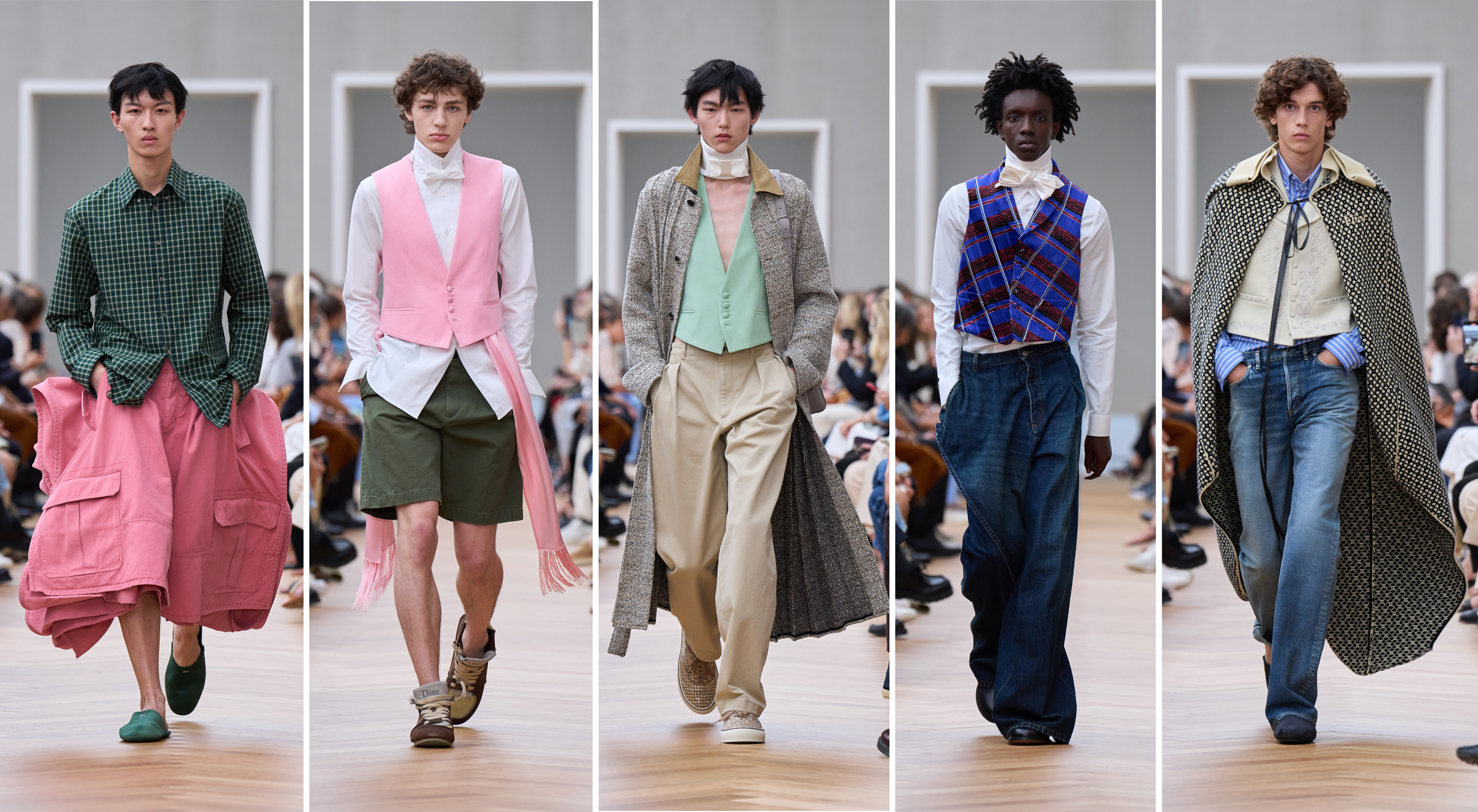
Dior
The most anticipated debut of the menswear calendar, Jonathan Anderson for Dior, was the hottest ticket of the week. Recreating a gallery space as the show venue, based on the Gemäldegalerie in Berlin; complete with two priceless works of art by Jean Baptiste Siméon Chardin on loan from the Louvre and National Galleries of Scotland. Anderson set about reinterpreting classic Dior codes and historical garments with a contemporary feel. In a preview he said his approach was to “decode to recode” – mixing “formality, a take on history with personal style”. The opening look of a bar jacket in Donegal tweed, as used by Dior in his first two collections, was worn with voluminous cargo shorts made from 15m of fabric that riffed on an archive dress. Faded jeans paired with embroidered waistcoats inspired by 18th-century styles from the court of Versailles. The Dior book tote got new covers including a bright yellow with red text Bram Stoker’s Dracula (a nod to Anderson’s Irish roots).
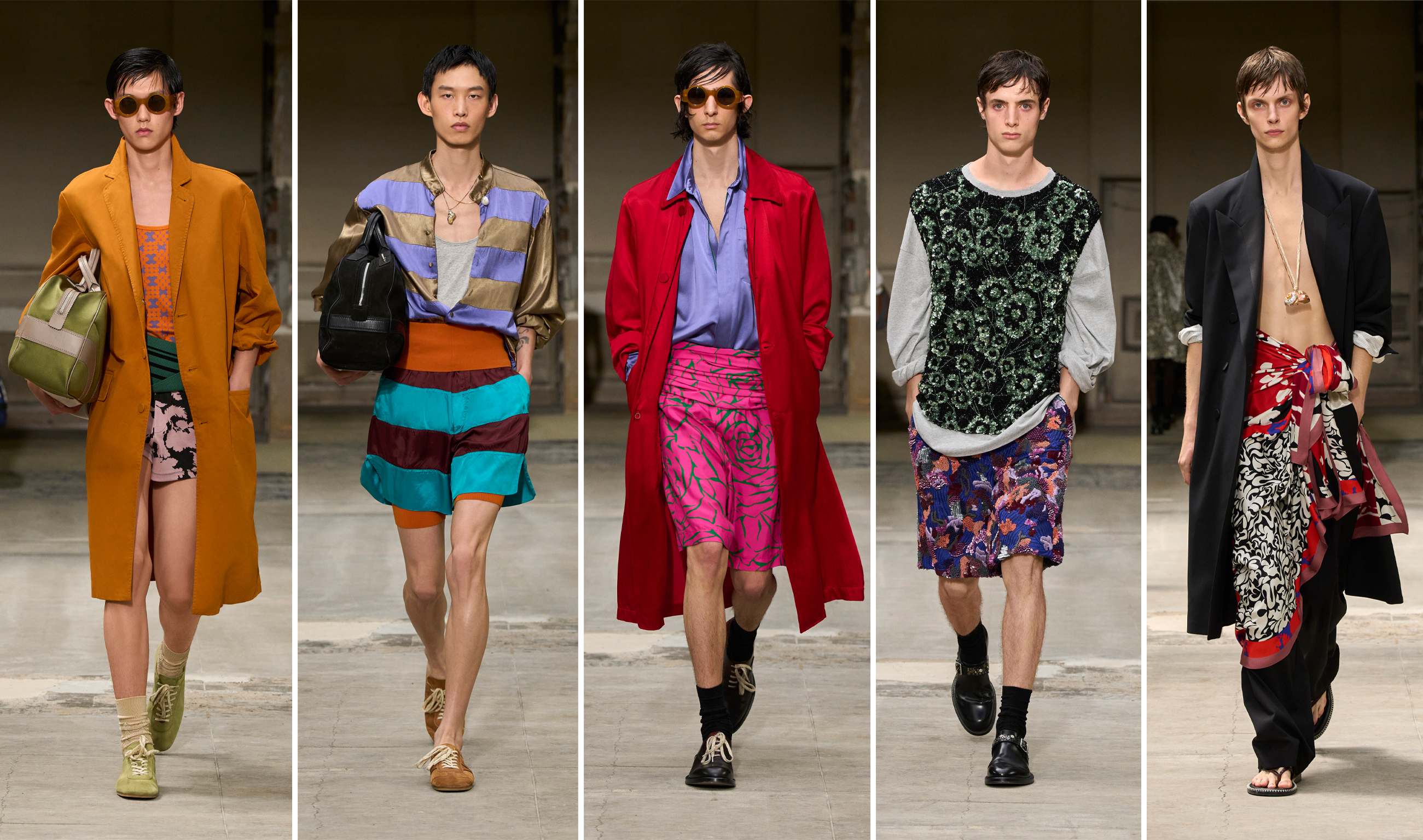
Dries Van Noten
Julian Klausner’s debut menswear runway collection received one of the most effusive reactions of the SS26 season. Set to a soundtrack of Lou Reed’s A Perfect Day, the collection walked the line between casual and formal with effortless ease and joy. “I had in mind the Dries Van Noten wardrobe I always loved; traditional yet daring, the different layers of dressing up.” Klausner said in the show notes. All the house codes from print and embroidery to colour and tailoring were exquisitely presented. Repurposed stripe jacquards from previous seasons ticked the pyjama trend, while silky jockey stripes on bold contrast colours added a fun twist. Multi-coloured sequin short sets were eye-catching and tuxedos came styled with printed sarongs worn over the trousers and minus shirts.
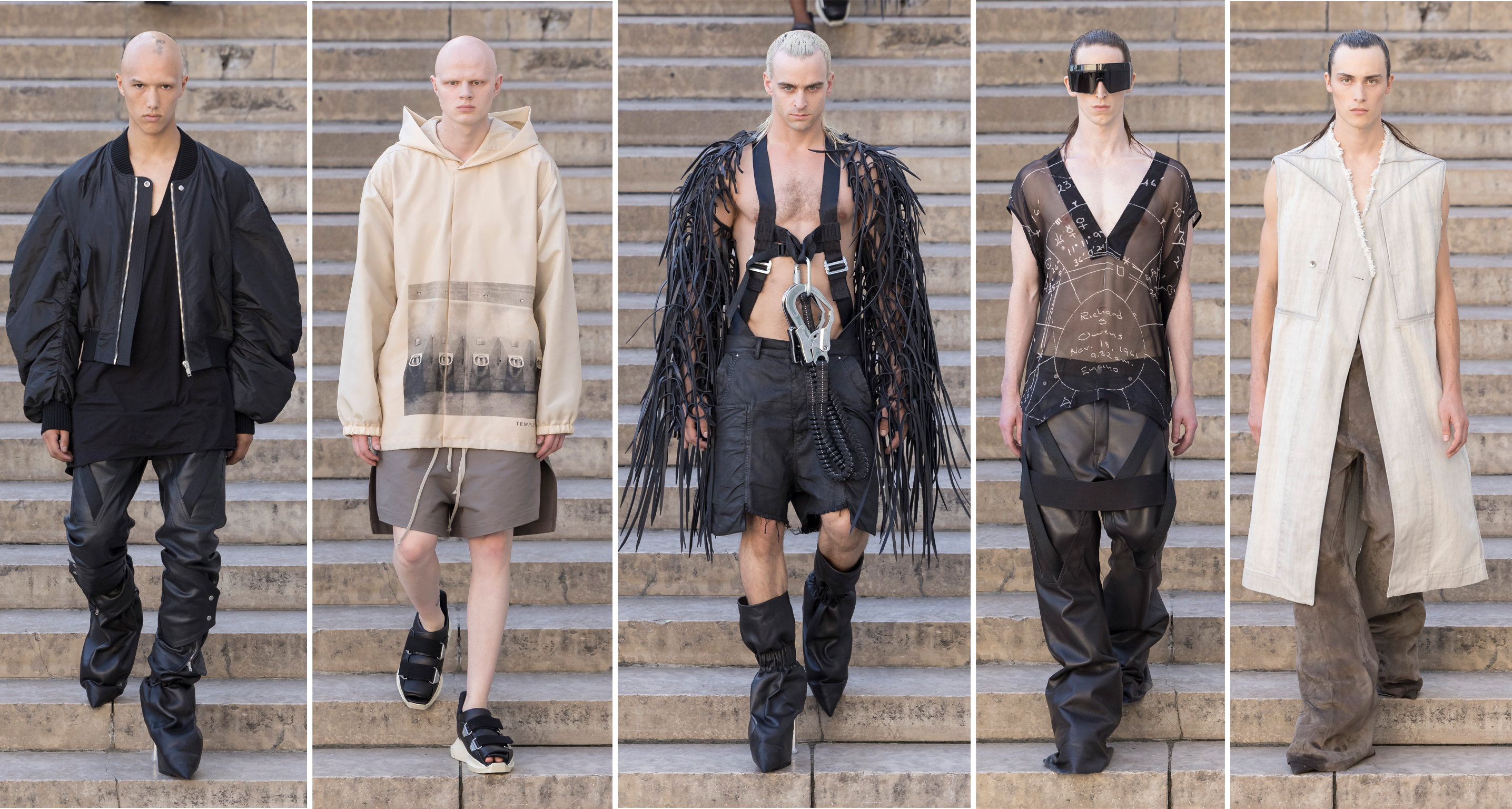
Rick Owens
SS26 gave us a double bill of Rick Owens, first his show at Palais d’Tokyo followed immediately by opening night of his retrospective “Temple of Love” over the road at Musée Palais Galliera. The show took place (as many previous summer seasons have) at the courtyard fountain, models climbed down a scaffold tower and waded through and dived under the water wearing a series of black slashed, fringed and zipped leather looks. Voluminously proportioned flight jackets and parkas in silk taffeta and canvas appeared alongside baggy shorts styled purposely with bare chests. The unforgettable finale saw five models scale the scaffold tower, secure themselves at the summit with the carabiner harnesses on their outfits, that revealed themselves to be both practical and aesthetic as they hung backwards while jets of water shot more than 20ft into the air around them.
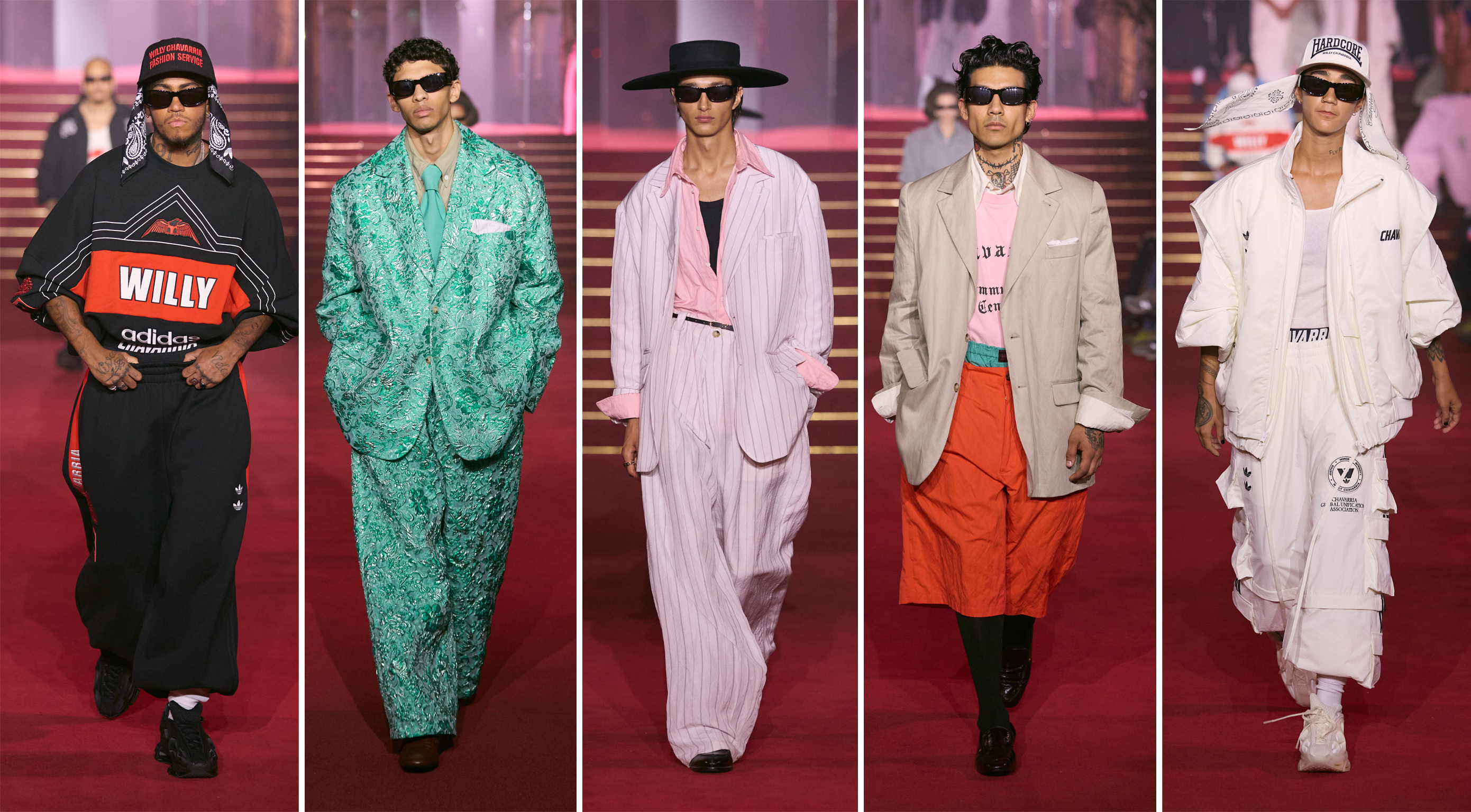
Willy Chavarria
The show opened with 35 men in white T-shirts made in partnership with the American Civil Liberties Union (ACLU), in reference to Salvadoran prisons where people are being profiled and persecuted without due process. “I offer this show as a prayer for souls caught in the shadow of ICE,” Chavarria stated in an Instagram post. The moving tribute doubled down on his determination “to celebrate unity while actively resisting oppression.” Chavarria’s work celebrates Latin-American culture and centres activism alongside design, championing the power of community. SS26 elevated tailoring that honours immigrant expression and craftsmanship. He used colour as a form of rebellion; outsize suit cuts in bold turquoise and pink appeared alongside sportswear, including an Adidas collaboration. The collection also featured womenswear by head of design Rebecca Mendoza. Fashion shows can often feel disconnected from world affairs. Chavarria’s moving opening statement proved the two can co-exist.
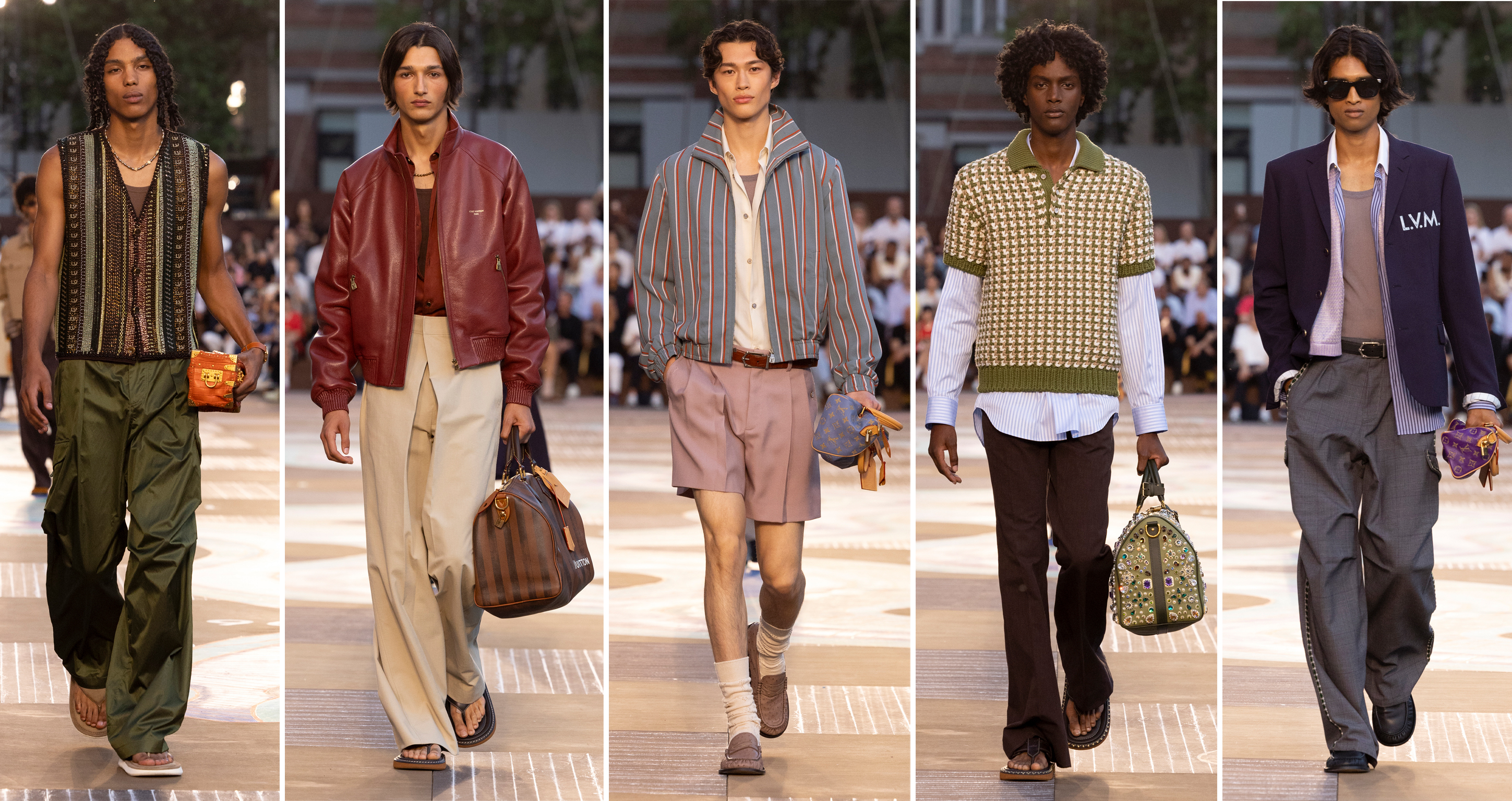
Louis Vuitton
For his fourth and strongest outing to date as creative director of Louis Vuitton, Pharrell commissioned Indian architect Bijoy Jain of Studio Mumbai to design a handpainted supersized snakes and ladders set, positioned in front of the Centre Pompidou. The collection title “Paris to India” took inspiration from the influence of modern Indian sartorialism on the global contemporary wardrobe. The soundtrack featured a Punjai song, Yaara, co-produced by Indian composer AR Rahman played by a live orchestra. On the runway looks included plenty of tailoring, stripes – the emblem of pyjamas and suiting alike also came on performance – and workwear. Traditional Indian beading decorated anorak hoods, trunks, shirt collars and suits. A motif of wild animals and palms designed by Louis Vuitton for Wes Anderson’s 2007 film The Darjeeling Limited (that has been criticised for being appropriative of Indian culture) appeared on tailoring and bags.
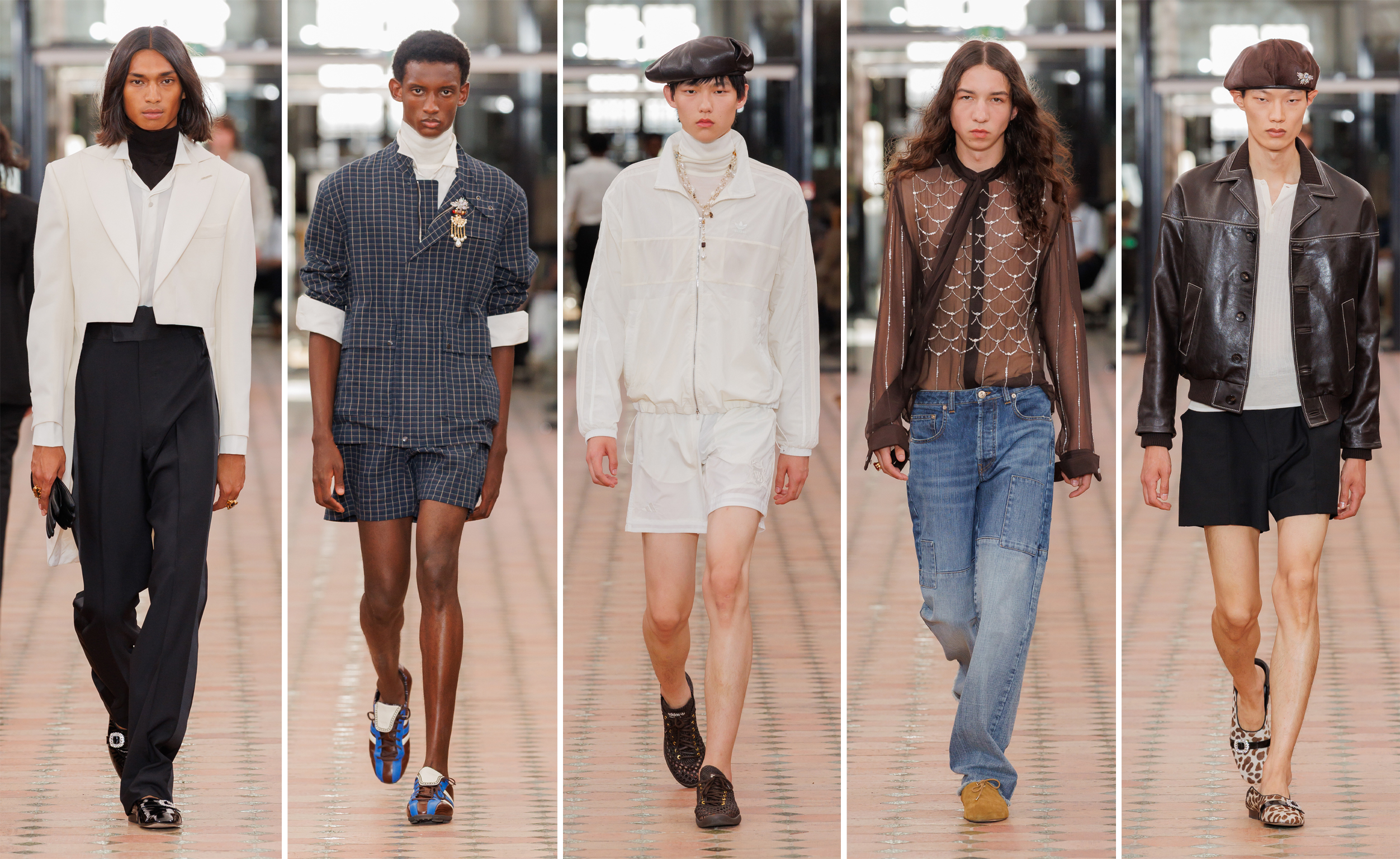
Wales Bonner
Grace Wales Bonner celebrated 10 years of her eponymous label with a show in the library of the prestigious Lycee Henri IV school. Backstage after the show, the designer said she was thinking of the Met Gala’s Superfine: Tailoring Black Style exhibition coming into this collection (she dressed, among others, co-chair Lewis Hamilton for the event). Channeling the opulence of 1930’s evening wear, including a tailcoat produced with Savile Row tailors Anderson & Sheppard and a beaded chiffon shirt, alongside relaxed utility silhouettes, aged denim and a new Y-3 collaboration. The recurring symbol of the lotus flower appears on lightweight shirting and summer outerwear. As the collection’s title “Jewel” suggests, every Wales Bonner piece is made with intent and intended to be treasured.
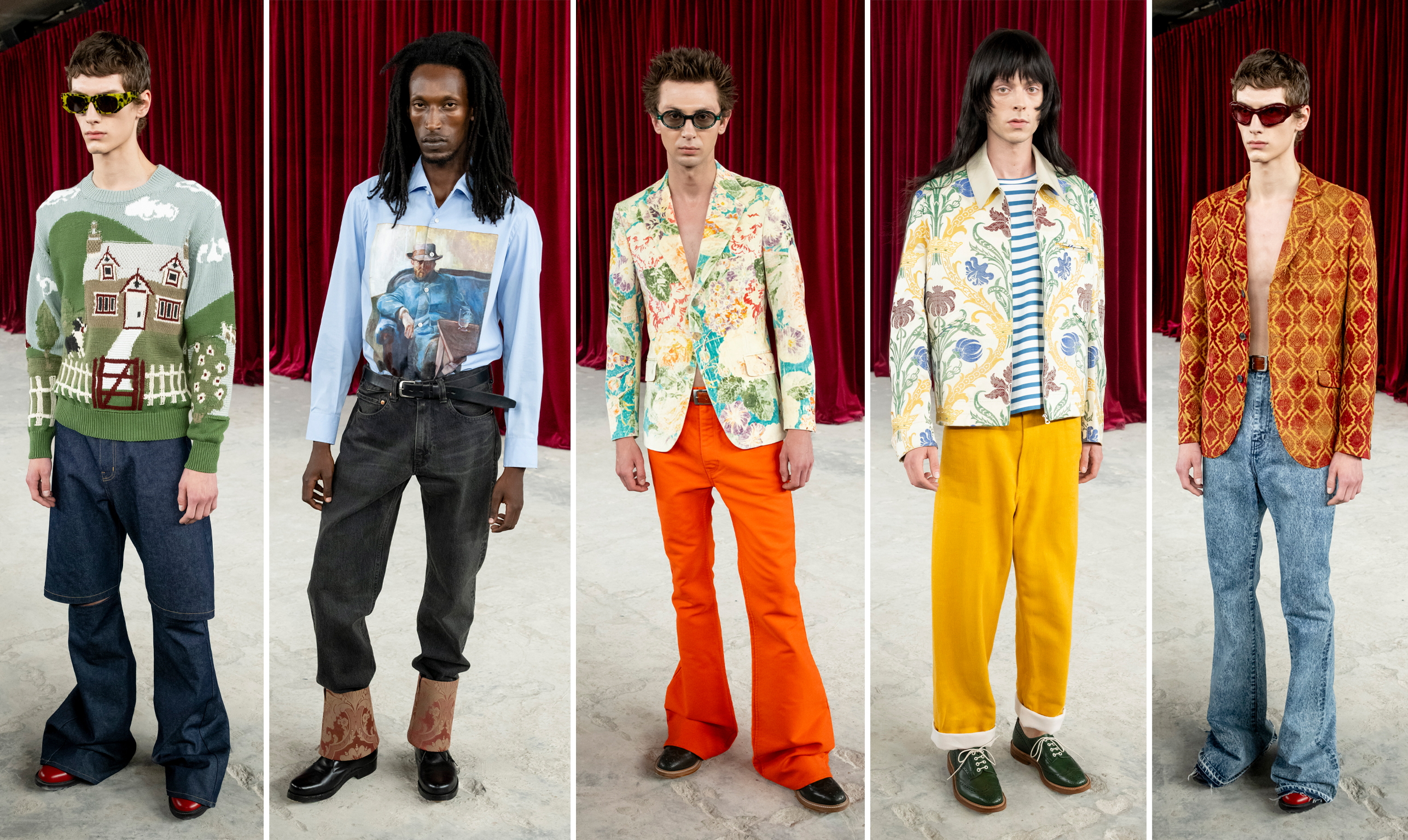
Junya Watanabe
Junya Watanabe referenced the suits made with upholstery fabrics for his AW04 collection, remaking them with new fabrics for SS26. “I took interest in something that is old but feels new, or something new that is born in the process of reproducing old things,” he explained in his show notes. The result was a highly covetable collection that explored a silhouette comprising of a fitted blazer with flared pants/jeans (a rising trend since that Kendrick Lamar Superbowl Celine denim moment). Novelty knitwear featuring bucolic scenes and statement shirts made in collaboration with heritage Italian shirt brands Luigi Borreli and Maria Santangelo featuring artworks by Tove Jansson and Edvard Munch stood out.
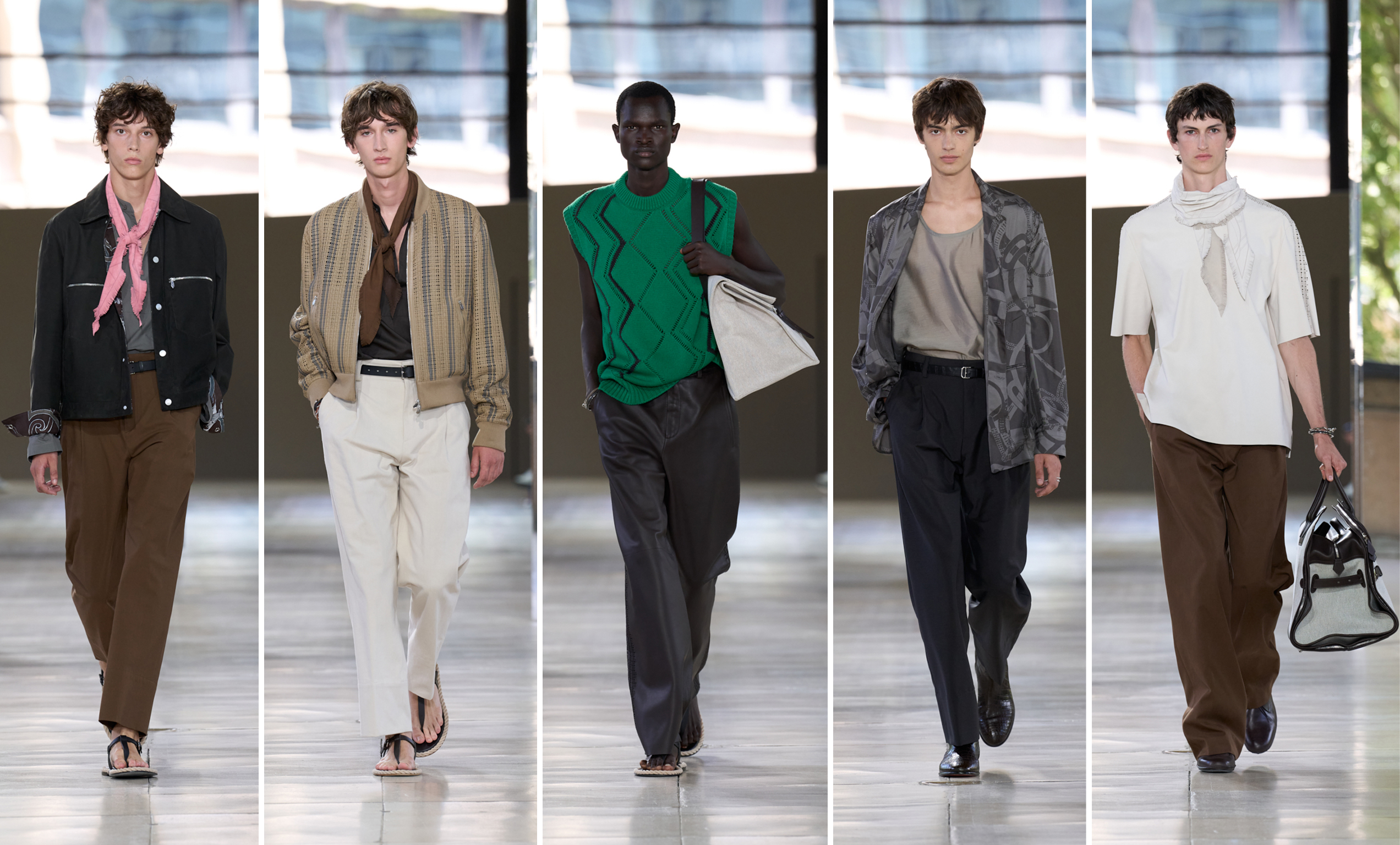
Hermès
Véronique Nichanian presented a summer in the city collection for Hermès SS26 – shorts and the colour black were notably absent from the 51-look collection, instead, a wardrobe of straight-leg and wider loose-pleated fronted trousers balanced with shorter jackets that was high on leather content. Think buttersoft leather T-shirts with open weave lattice details across shoulder and side seams, super lightweight jackets or full lattice-leather bombers. A cool tonal colour palette of putty, caramel and coffee with accents of mint green and putty pink. Hermès scarf prints came on silk twill blazers and shirts that looked ideal for vacation evenings. Oversized bags, some featuring a fun monkey print, were carried throughout.
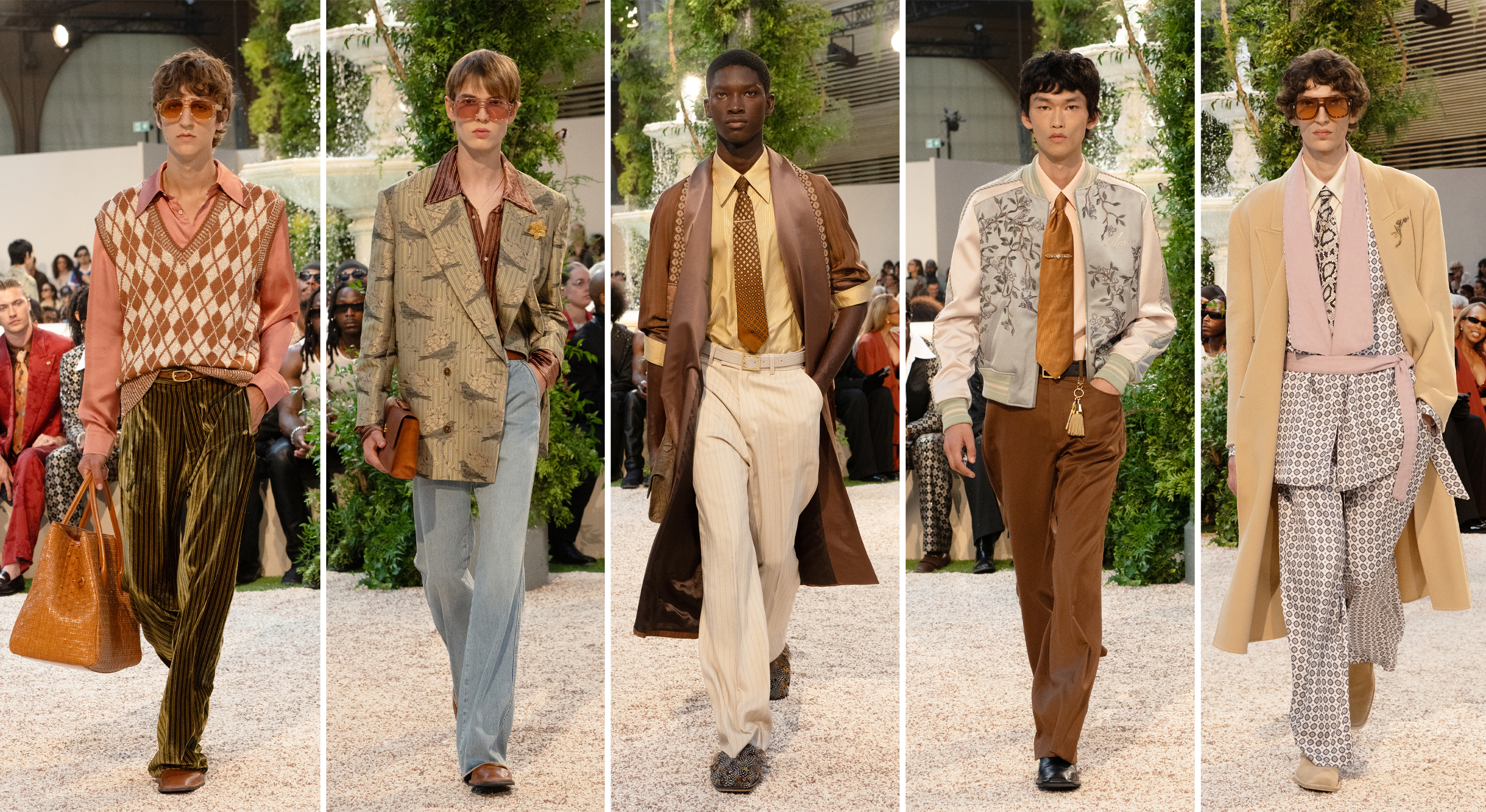
Amiri
Mike Amiri took the fantasy “Chateau Amiri” hotel as the starting point for his SS26 collection. The design language of five-star hotel life is referenced via monogrammed slippers and robes, tasseled key fobs and rich upholsteries. Patterns mimic hotel décor, monograms, and wallpaper. Bird prints were painted by Amiri’s artist friend Wes Lang. Old school Hollywood glamour is part of the brand's DNA. Silhouettes echo the late 1970s, cut with a swagger, and silk pyjamas are worn with embellished evening jackets. The colour palette of sun-bleached tones of mint, raspberry, pale blue, and gold felt optimistic.
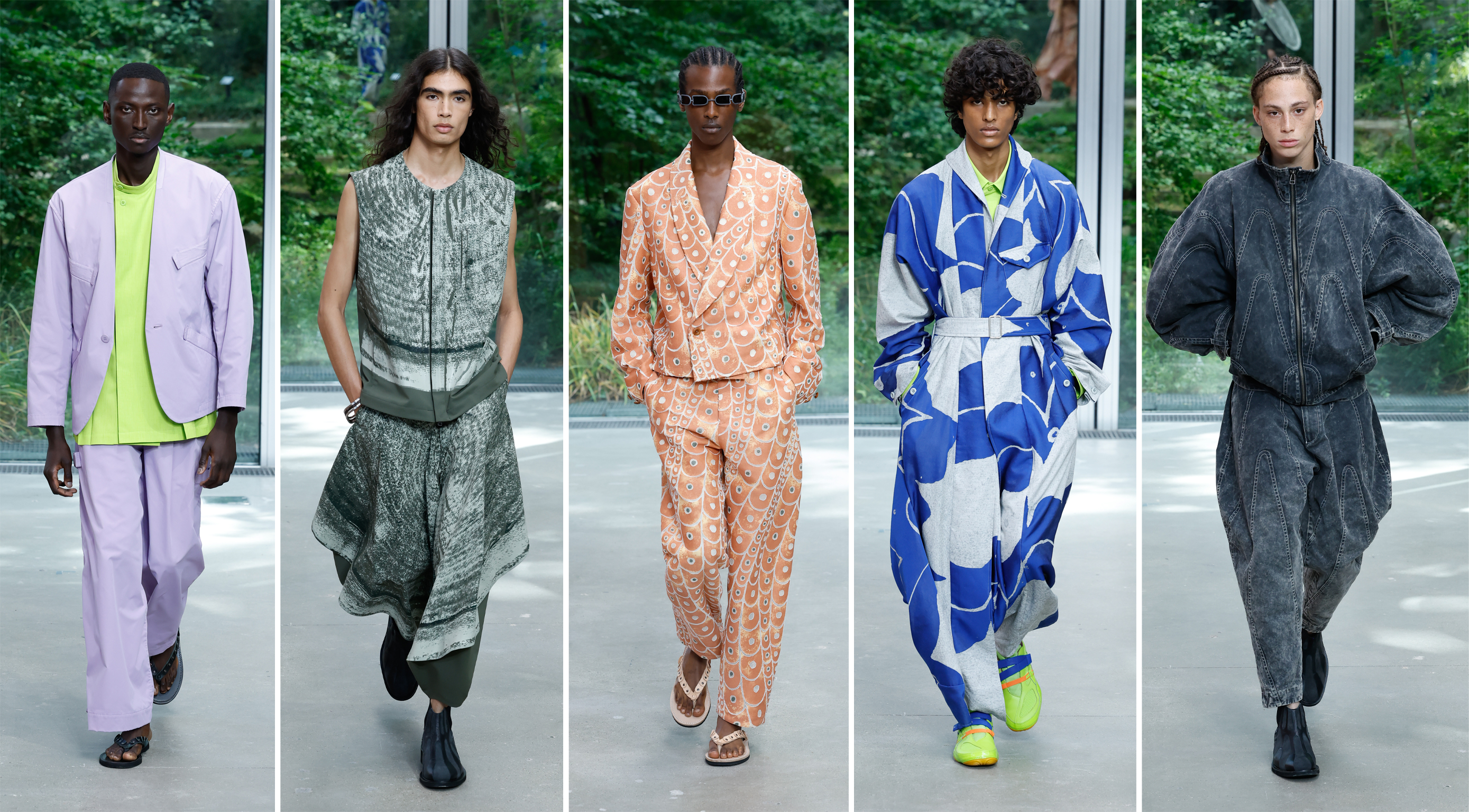
IM Men
Titled “Dancing Texture”, the IM Men SS26 collection from Issey Miyake opened with performers cloaked in graphic patterned hooded outfits that covered their faces, they moved as one with swaths of the same fabric suspended from the ceiling. Taking inspiration from Osaka-born and Kyoto-trained ceramic artist Shoji Kamoda’s work, translating the textures of his work into garments. Including his Kaiyu and Urokomon ceramics that used plant-ash glazes and featured striking animal-like scale patterns. The blouson and pants from the Kaiyu series are designed to form a circle when laid flat and were printed while in their flattened state. Some looks were made from nylon fabric partially woven from recycled used fishing nets collected in Japan. A new footwear development project made with Asics was also presented.

